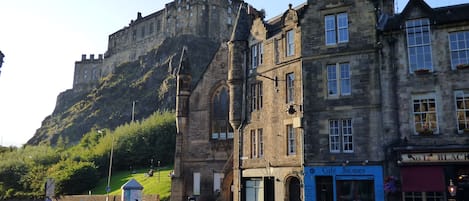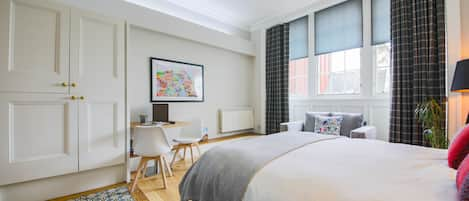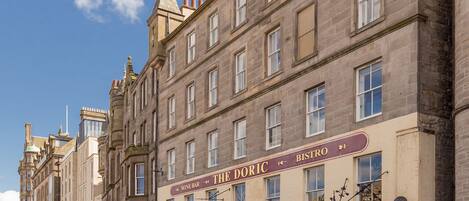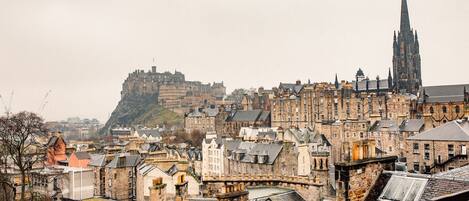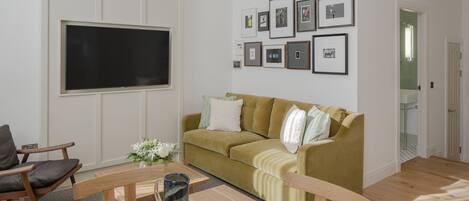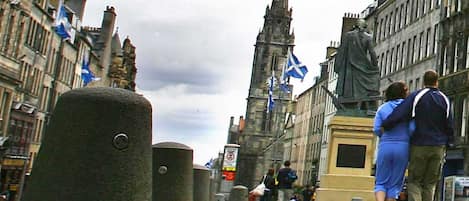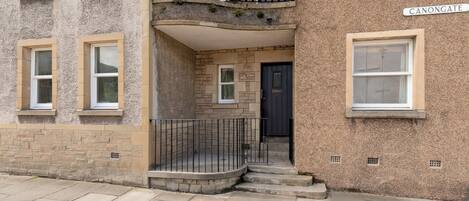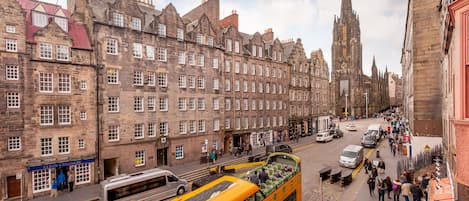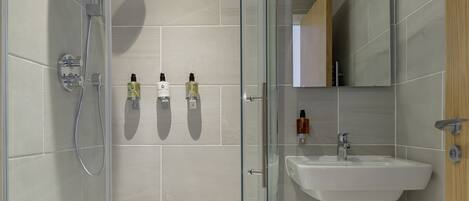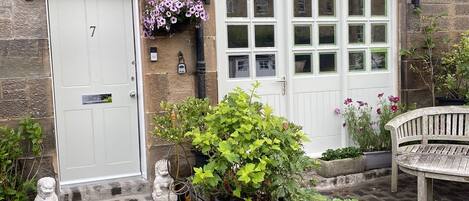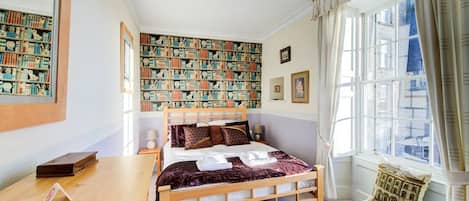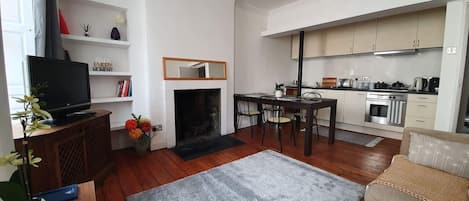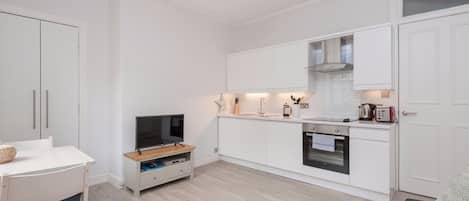Apartment
Ord’s Loft - Royal Mile Historic Luxury Apartment
Photo gallery for Ord’s Loft - Royal Mile Historic Luxury Apartment
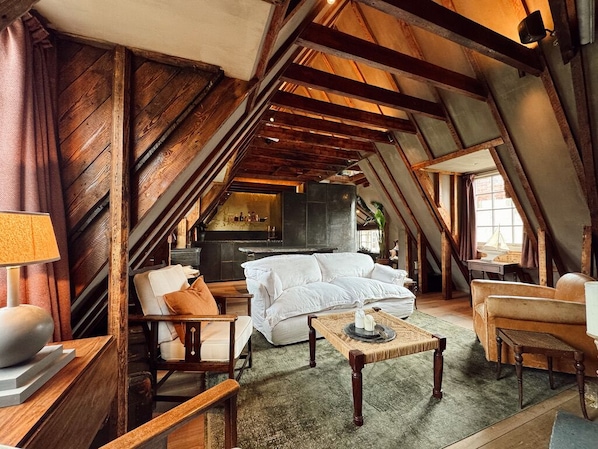
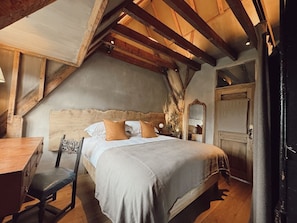
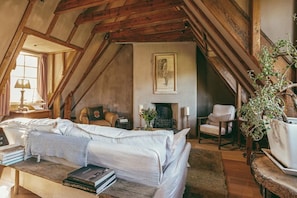
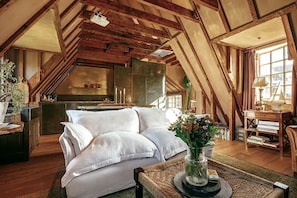

Reviews
10 out of 10
Exceptional
1 bedroom1 bathroomSleeps 275 sq m
Popular amenities
Explore the area
Edinburgh, Scotland
- Royal Mile11 min walk
- Edinburgh Playhouse Theatre14 min walk
- Edinburgh Castle19 min walk
- Edinburgh (EDI)42 min drive
Rooms & beds
1 bedroom (sleeps 2)
1 bathroom
Bathroom 1
Spaces
About this property
Ord’s Loft - Royal Mile Historic Luxury Apartment
Ord’s Loft, situated in White Horse Close, is one of the most desirable and unique properties in Edinburgh’s old town. Positioned on the top floor of what was once the White Horse Coaching Inn, built by Laurence Ord in 1624, the loft is entered by the iconic steps seen in so many photos of Edinburgh. The outlook south over the courtyard is Holyrood Palace, Arthurs Seat, the Scottish Parliament and the Old Town while to the rear it looks up to Regent Road and Calton Hill.
The space
The loft, which is nestled in a picture-postcard courtyard at the foot of the Royal Mile, has been lovingly restored and reimagined by combining 17th Century character with modern luxuries. As this is such an historic building, the interior has been constructed with traditional building methods and materials, including exposed rafters, lime and polished plasters, with solid hardwood floors and natural fabrics like linen and wool throughout.
Prestigious Maker & Sons sofa, renowned for comfort, a drop down cinema screen and underfloor heating, are blended with genuine `Scottish antique furniture, woven tweeds and polished, lime plaster walls. The bedroom is furnished with an Harrison Spinks cashmere, super-king mattress, Scottish waney-edge oak headboard and antique furniture as well as 400 thread count luxury bedlinen. The bathroom walls and shower are lined with Moroccan ‘tadelakt’ and the sound system plays throughout the whole apartment.
The kitchen feels like it's part of the fabric of the room, subtle tones of the plaster are offset with solid brass highlights. The centre island, a salvaged Georgian kitchen base-unit with a slice of green chlorite-schist volcanic rock atop, was hand selected and cut from the Loch Sween quarry in the Mull of Kintyre. This same type of stone is renowned as the carving stone for Celtic crosses and monuments of Scotland and Ireland throughout the centuries. The timber kitchen units are handmade and appliances include, Miele fridge / freezer, Gaggenau hob with downdraft, Fisher Paykel double oven and grill, whilst the kitchen itself is furnished with traditional china and glassware and some typical Scottish whisky and snacks to welcome you to Edinburgh.
Ord’s Loft is a home from home, where the relaxed atmosphere and character of the space allows you to step back in time, whilst the location allows you to step out into the top tourist attractions and amenities of the historic city right outside your door.
HISTORY:
Beneath the outer layers of the picturesque architecture in Edinburgh’s Old Town, lies an intertwined mesh of closes and hidden alleyways and one of the most deceptively intricate areas in any city in the world, which you will be able to explore when you visit.
White Horse Close is a small courtyard surrounded by several vernacular buildings with outside steps and pan-tiled roofs. The close was originally called Ord’s Close, named after the 17th Century entrepreneur, Lawrence Ord, who created the inn, lodgings and stables for people journeying to and from Edinburgh. By 1623 the White Horse Coaching Inn was the terminus for stagecoaches and a bustling hotspot for travellers at the end of a long hard journey from London. Around the same time the close seems to have been renamed White Horse Close.
The origin of the name is a great topic of conversation because there are so many theories, though nobody knows for sure which is correct. The location has always been associated with the royal mews from the period of Mary Queen of Scots, who was an excellent horsewoman. It is said that her favourite white mare was stabled there, near to the entrance to the royal palace and at times she would secretly escape the palace in disguise, so that she could ride freely around the Edinburgh countryside. Mary Queen of Scots led a very dramatic life and was persecuted and betrayed by many during her reign at the Palace and some say that her trusted, white horse was stabbed to death in the royal mews, possibly giving vent to the name. Another suggestion is that the name comes from the White Horse of Hanover which was introduced into the Royal Arms in 1714 when the crown passed to George 1, King of Great Britain and Ireland. Whatever the correct story is, it’s sure to have a royal connection.
The White Horse Inn was on the ground floor, with the lodgings above and Lawrence Ord, could oversee his thriving business from the top floor of the building. A covered vennel slips under the building and down to the lower road where the entrance to the stables, blacksmith and stagecoaches were. The clatter of hooves and the steam from the horses would have worked its way up into the courtyard to create a real hustle and bustle of life. Luggage would have been carried up the passage for the travellers who were lodging on all floors of the guest house. Food would have been prepared and consumed by tired hungry guests, while casks of whisky, wine, gin, port and ale would have been hoisted and rolled behind the bar and swilled down faster than they could get it in the door. This close has witnessed history unfold throughout the centuries, through changes of the crown, Bonnie Prince Charlie’s Jacobite Rising, the Scottish Enlightenment and the new Scottish Parliament.
In 1639 the country was in religious turmoil which led to the ‘Stoppit Stravaig’ when many nobles and leaders of the Covenanting Party were in open disagreement of King Charles 1, and his religious doctrine. When a group were overheard in the inn to be planning a secret rendezvous to air their complaints, Presbyterian ministers gathered a mob and laid siege to them at the inn, barring them from leaving. Somehow, James Graham, the Earl of Montrose managed to escape them, met the King and but was persuaded to profess allegiance to him. Sadly, he had to pass the close again ten years later in 1650, this time, on the way to his execution for treason.
Because the courtyard was safely enclosed, its also believed that the inn was used to house the Jacobite officers during Charles Edward Stuart’s occupation of Holyrood Place during the Jacobite Rebellion of 1745. When you stand in the courtyard, it is easy to imagine the Jacobites raising their glasses at the inn, armed and ready to defend their Bonnie Prince Charlie.
Scotland was one of the first country’s in the world to give free education to all, so it is no surprise that during the late 18th century, there was a period of great enlightenment, characterised by an outpouring of intellectual and scientific accomplishments. Among the fields that rapidly advanced were philosophy, political economy, engineering, architecture, medicine, geology, archaeology, botany and zoology, law, agriculture, chemistry and sociology. The Royal Mile was a hotbed for some of the most notable characters of the enlightenment, Adam Smith, David Hume, Sir Patrick Geddes who all lived within a stone’s throw of White Horse Close.
In 1793, a farrier (most likely working in the White Horse stables) lived in White Horse Close and his wife gave birth to William Dick in one of the courtyard houses that now bears his name. It’s no surprise that as William grew up in this period of great learning, he became an exemplary student and notably went on to be the founder of the renowned Royal Dick School of Veterinary Studies.
Towards the end of the 18th century, many of the wealthy were moving to Edinburgh’s New Town due to overcrowding around the Old Town. Doctor Alexander Barbour and his sister bought the buildings in the close and set about a renovation of them with Edinburgh Social Union. Most of the buildings were altered to create healthier living quarters, but by 1960, it had to go through another series of alterations and restoration carried out by the City of Edinburgh. At this time, some of the stairways, balconies and walls were removed and rebuilt.
Thankfully the original character was not lost and we are able to step back 400 years in time and still imagine it all.
The space
The loft, which is nestled in a picture-postcard courtyard at the foot of the Royal Mile, has been lovingly restored and reimagined by combining 17th Century character with modern luxuries. As this is such an historic building, the interior has been constructed with traditional building methods and materials, including exposed rafters, lime and polished plasters, with solid hardwood floors and natural fabrics like linen and wool throughout.
Prestigious Maker & Sons sofa, renowned for comfort, a drop down cinema screen and underfloor heating, are blended with genuine `Scottish antique furniture, woven tweeds and polished, lime plaster walls. The bedroom is furnished with an Harrison Spinks cashmere, super-king mattress, Scottish waney-edge oak headboard and antique furniture as well as 400 thread count luxury bedlinen. The bathroom walls and shower are lined with Moroccan ‘tadelakt’ and the sound system plays throughout the whole apartment.
The kitchen feels like it's part of the fabric of the room, subtle tones of the plaster are offset with solid brass highlights. The centre island, a salvaged Georgian kitchen base-unit with a slice of green chlorite-schist volcanic rock atop, was hand selected and cut from the Loch Sween quarry in the Mull of Kintyre. This same type of stone is renowned as the carving stone for Celtic crosses and monuments of Scotland and Ireland throughout the centuries. The timber kitchen units are handmade and appliances include, Miele fridge / freezer, Gaggenau hob with downdraft, Fisher Paykel double oven and grill, whilst the kitchen itself is furnished with traditional china and glassware and some typical Scottish whisky and snacks to welcome you to Edinburgh.
Ord’s Loft is a home from home, where the relaxed atmosphere and character of the space allows you to step back in time, whilst the location allows you to step out into the top tourist attractions and amenities of the historic city right outside your door.
HISTORY:
Beneath the outer layers of the picturesque architecture in Edinburgh’s Old Town, lies an intertwined mesh of closes and hidden alleyways and one of the most deceptively intricate areas in any city in the world, which you will be able to explore when you visit.
White Horse Close is a small courtyard surrounded by several vernacular buildings with outside steps and pan-tiled roofs. The close was originally called Ord’s Close, named after the 17th Century entrepreneur, Lawrence Ord, who created the inn, lodgings and stables for people journeying to and from Edinburgh. By 1623 the White Horse Coaching Inn was the terminus for stagecoaches and a bustling hotspot for travellers at the end of a long hard journey from London. Around the same time the close seems to have been renamed White Horse Close.
The origin of the name is a great topic of conversation because there are so many theories, though nobody knows for sure which is correct. The location has always been associated with the royal mews from the period of Mary Queen of Scots, who was an excellent horsewoman. It is said that her favourite white mare was stabled there, near to the entrance to the royal palace and at times she would secretly escape the palace in disguise, so that she could ride freely around the Edinburgh countryside. Mary Queen of Scots led a very dramatic life and was persecuted and betrayed by many during her reign at the Palace and some say that her trusted, white horse was stabbed to death in the royal mews, possibly giving vent to the name. Another suggestion is that the name comes from the White Horse of Hanover which was introduced into the Royal Arms in 1714 when the crown passed to George 1, King of Great Britain and Ireland. Whatever the correct story is, it’s sure to have a royal connection.
The White Horse Inn was on the ground floor, with the lodgings above and Lawrence Ord, could oversee his thriving business from the top floor of the building. A covered vennel slips under the building and down to the lower road where the entrance to the stables, blacksmith and stagecoaches were. The clatter of hooves and the steam from the horses would have worked its way up into the courtyard to create a real hustle and bustle of life. Luggage would have been carried up the passage for the travellers who were lodging on all floors of the guest house. Food would have been prepared and consumed by tired hungry guests, while casks of whisky, wine, gin, port and ale would have been hoisted and rolled behind the bar and swilled down faster than they could get it in the door. This close has witnessed history unfold throughout the centuries, through changes of the crown, Bonnie Prince Charlie’s Jacobite Rising, the Scottish Enlightenment and the new Scottish Parliament.
In 1639 the country was in religious turmoil which led to the ‘Stoppit Stravaig’ when many nobles and leaders of the Covenanting Party were in open disagreement of King Charles 1, and his religious doctrine. When a group were overheard in the inn to be planning a secret rendezvous to air their complaints, Presbyterian ministers gathered a mob and laid siege to them at the inn, barring them from leaving. Somehow, James Graham, the Earl of Montrose managed to escape them, met the King and but was persuaded to profess allegiance to him. Sadly, he had to pass the close again ten years later in 1650, this time, on the way to his execution for treason.
Because the courtyard was safely enclosed, its also believed that the inn was used to house the Jacobite officers during Charles Edward Stuart’s occupation of Holyrood Place during the Jacobite Rebellion of 1745. When you stand in the courtyard, it is easy to imagine the Jacobites raising their glasses at the inn, armed and ready to defend their Bonnie Prince Charlie.
Scotland was one of the first country’s in the world to give free education to all, so it is no surprise that during the late 18th century, there was a period of great enlightenment, characterised by an outpouring of intellectual and scientific accomplishments. Among the fields that rapidly advanced were philosophy, political economy, engineering, architecture, medicine, geology, archaeology, botany and zoology, law, agriculture, chemistry and sociology. The Royal Mile was a hotbed for some of the most notable characters of the enlightenment, Adam Smith, David Hume, Sir Patrick Geddes who all lived within a stone’s throw of White Horse Close.
In 1793, a farrier (most likely working in the White Horse stables) lived in White Horse Close and his wife gave birth to William Dick in one of the courtyard houses that now bears his name. It’s no surprise that as William grew up in this period of great learning, he became an exemplary student and notably went on to be the founder of the renowned Royal Dick School of Veterinary Studies.
Towards the end of the 18th century, many of the wealthy were moving to Edinburgh’s New Town due to overcrowding around the Old Town. Doctor Alexander Barbour and his sister bought the buildings in the close and set about a renovation of them with Edinburgh Social Union. Most of the buildings were altered to create healthier living quarters, but by 1960, it had to go through another series of alterations and restoration carried out by the City of Edinburgh. At this time, some of the stairways, balconies and walls were removed and rebuilt.
Thankfully the original character was not lost and we are able to step back 400 years in time and still imagine it all.
Property manager
JAMES STRONG
Languages
English
Add dates for prices
Amenities
Washer
Have a question?
BetaGet instant answers with AI powered search of property information and reviews.
Similar properties
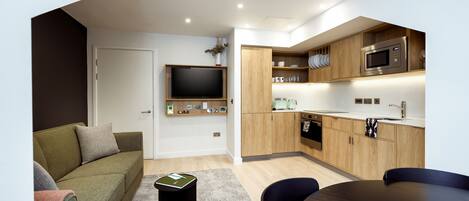
Wilde Aparthotels, Edinburgh, Grassmarket
Wilde Aparthotels, Edinburgh, Grassmarket
- Kitchen
- Free WiFi
- Restaurant
- Air conditioning
9.4 out of 10, (838 reviews)
House Rules
Children
Children allowed: ages 0–17
Events
No events allowed
Pets
No pets allowed
Smoking
Smoking is not permitted
Important information
You need to know
Extra-person charges may apply and vary depending on property policy
Government-issued photo identification and a credit card, debit card or cash deposit may be required at check-in for incidental charges
Special requests are subject to availability upon check-in and may incur additional charges; special requests cannot be guaranteed
On-site parties or group events are strictly prohibited
Long-term renters welcome
Host has indicated that there is a carbon monoxide detector on the property
Host has indicated that there is a smoke detector on the property
About the area
Edinburgh
Old Town Edinburgh, a neighbourhood in Edinburgh, is home to this apartment. Royal Mile and Edinburgh Castle are notable landmarks, and travellers looking to shop may want to visit Princes Street and George Street. Check out an event or a game at Edinburgh International Conference Centre, and consider making time for Edinburgh Zoo, a top attraction not to be missed.
Edinburgh, Scotland
What's nearby
- Princes Street - 8 min walk - 0.7 km
- Royal Mile - 11 min walk - 0.9 km
- Edinburgh Playhouse Theatre - 14 min walk - 1.2 km
- University of Edinburgh - 18 min walk - 1.6 km
- Edinburgh Castle - 19 min walk - 1.6 km
Getting around
Restaurants
- The Canons' Gait - 7 min walk
- Cafe at the Palace - 3 min walk
- BrewDog DogHouse Edinburgh - 7 min walk
- Piggs - 8 min walk
- Tolbooth Tavern - 5 min walk
Frequently asked questions
Reviews
Reviews
No reviews yet
Be the first to leave a review for this property after your stay.
About the host
Hosted by JAMES STRONG
Languages:
English
Tell us how we can improve our siteShare feedback
